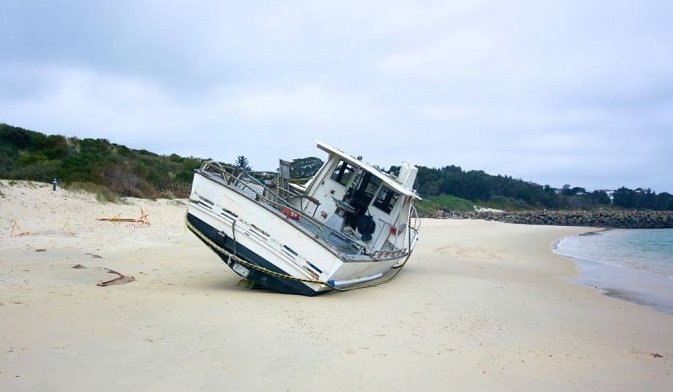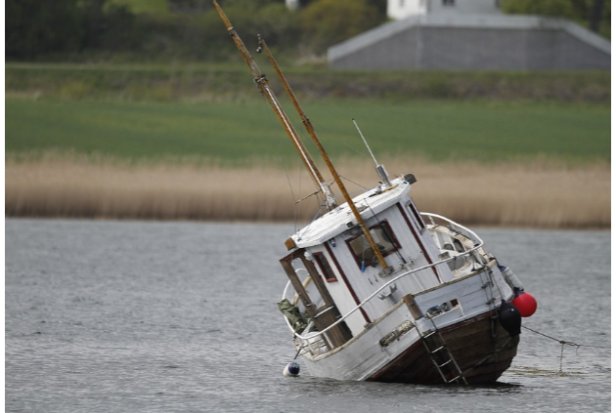Reversing off is the first option if your boat runs aground. You might be able to simply reverse off from where your boat is grounded if the damage is not too severe.
What is Running Aground?
When the water is too shallow to keep a boat afloat, it runs aground. Sometimes this is done on purpose, for example to perform maintenance or to land cargo, but it usually happens because of inaccurate information about water depths, operator error, or a change in the bottom structure of a waterway.
What is the Best Way to Avoid Running Aground?
Unfortunately, boaters often experience running aground. However, it is not necessary.
If you abide by these three rules, you should be able to avoid hitting underwater obstacles like rocks, sandbars, and other obstructions that will put an abrupt end to your enjoyable boating day.
- Take some time before launch to consult a nautical chart of the area if you’re boating in uncharted waters. Get the inside scoop on nearby underwater hazards by speaking with local marinas and boaters. They are aware of where to go and where to avoid.
- When boating, always keep a proper eye out. You should be on the lookout for buoys and markers that indicate shallow waters, but you should also be on the lookout for shoals and sandbars that can be difficult to spot. It might surprise you to learn that the majority of accidents take place on clear, calm days with little wind. Boaters frequently get into trouble by simply failing to keep an eye out.
- Always drive at a safe speed. By doing this, you’ll be able to take the necessary steps if you come across an underwater danger that needs to be avoided.
A shallow alarm alert can be set on a depth finder to warn you if you are heading in the wrong direction. This is the last piece of advice.
But keep in mind that using a depth finder does not eliminate the requirement to maintain a proper lookout at all times. Never solely rely on a depth finder.
What Should You Do If Your Boat Runs Aground?
The first step after an accident is to stop and evaluate the situation. Therefore, turn off the engine and see if anyone is seriously hurt.
If the solution is yes, dial 911 on your VHF radio and immediately broadcast a distress signal to other boaters to let them know you require assistance.
Take a moment to inspect your boat’s hull if no one is seriously hurt and you are not in danger right away.
Has the vessel suffered any significant structural damage? Are there any leaks or cracks visible?
If so, do not go into deeper water; remain where you are. Bring your boat close to land now. To get a tow or request help, signal another boater.
The time has come to attempt releasing your boat if there is no structural damage.
One of the following techniques might be able to help you get back on the open water, depending on what you’re grounded on and how badly your boat is hung up.
Turning around is the first. You might be able to simply reverse off from where your boat is grounded if the damage is not too severe. Put your engine in reverse, tilt the outboard or inboard/outboard engine slightly upward, and then move some weight away from the area where the boat is grounded. Attempt to reverse your boat into a clear area of water now.
Another approach is to push off. Turn off your engine if trying to reverse out doesn’t work. Lift your outboard motor out of the water if you have one. Change some of the boat’s weight to the area that is not grounded now. Use your spare oar or paddles to push off the bottom once the boat’s grounded portion is no longer bearing weight. You might be able to stand on the sandbar and try to push your boat off if you ground your boat on a sandbar if there is enough sand around your boat. Lift the bow or stern of your boat and push it into deeper water while your engine is off.
Finally, you might need to use a kedge anchor. A small, lightweight anchor called a kedge anchor is used to pull a grounded boat out of its current situation. Typically, a small dinghy will be used to transport a kedge anchor from shore. But you can also carry the anchor while walking to your boat by using a PFD or other flotation device as a support.
When you get to the boat, fasten the kedge anchor to the anchor line, set your anchor firmly on the seabed, and then use it to free the boat from its current situation.

How to Get Your Boat Unstuck
In the absence of rescuers, I do not advise refloating your severely damaged boat. There are a number of ways to refloat your watercraft, though, if the grounding was only soft.
Step 1. Wait for High Tide
Even though it may take some time, waiting for the high tide can help you safely escape your predicament.
Step 2. Lighten the Load
To lighten the boat and increase the likelihood that it will refloat, place your passengers, heavy equipment, and other items into a dinghy. Pump the bilges and drain the water tanks are other options.
Step 3. Shift Your Weight
Head for the stern or the area of the boat that is farthest from the area where the boat ran aground. In doing so, you might end up with a heavier trailing edge and a front section that is freed from its embedding.
Step 4. Push Your Boat
The embedded section can also be pushed toward deeper water by getting out of your boat. You can also enlist the assistance of others to push the boat back into the water.
Step 5. Reverse Off
You can start your engine and slowly reverse it if it’s still submerged in water. It would be a good idea to keep in mind that this maneuver only works if you hit soft ground and there is deeper water you can reverse into.
How to Avoid Running Aground
The best strategy, of course, is to avoid running aground in the first place, even though there are many tricks you can use to escape when you’ve run aground. Knowing how to keep from running aground is essential to keep your boating day fun and stress-free:
- Study navigational charts: If you’re going to be boating in uncharted waters, spend some time studying the navigational charts before you leave. You can navigate more steadily if you are aware of the depths and features you will be entering with your boat.
- Talk to knowledgeable people: Consider spending some time before you leave talking to local boaters or marina staff. They can help you become aware of hidden or difficult-to-see hazards in the water.
- Stay in a clearly marked channel: Your guides to safe waters and hazards are buoys and beacons. Use the Coast Guard’s guide to beacons and buoys and what they mean to educate yourself.
- Carry charts in the boat: Carry and be familiar with local charts to prevent running aground. A quick look at your charts can help you sort things out if you can’t find the marking buoys or if you’re unsure of which areas are difficult to navigate.
- Stay alert: Although it’s simple to get carried away by the excitement of the glistening blue waters, cloudless sky, and joyous atmosphere of a day of boating, it’s important to remain aware of your surroundings. The primary factor in 654 boating accidents and 437 injuries in 2018 alone, according to the most recent Coast Guard statistics, was operator inattention. Don’t be fooled into thinking you are safe because it’s a lovely, calm day. Watch out for warning buoys, shoals, and sandbars that aren’t marked. Running aground can result from even a brief lapse in concentration.
- Proceed at a reasonable speed: In the United States, excessive speed is the fifth most frequent reason for boating collisions, accounting for 276 collisions and 231 injuries in 2018. Even though it’s a lot of fun to zoom across the water in a powerboat, only open the throttle when you’re certain you have enough room and enough water depth to do so safely. If not, keep your speed safe so you have time to react to any unanticipated hazards in the water.
- Use your depth finder: Taking soundings every few minutes is not necessary; if you have a depth finder, set it to warn you whenever you approach shallow water. To avoid distraction, never let your depth finder take the place of your focus. You should always pay attention to your surroundings even though it is there to help you.
Conclusion
Now that you are aware of what to do first, should your boat run aground, When your boat runs aground, one thing becomes obvious. Never panic because a calm mind can come up with better ideas to get yourself out of a precarious situation.
Make certain you have the necessary equipment on board in case your boat becomes stuck. Try the straightforward choice first, being wise. Then, evaluate the circumstance to determine the best course of action because there may be times when you need assistance from others.

